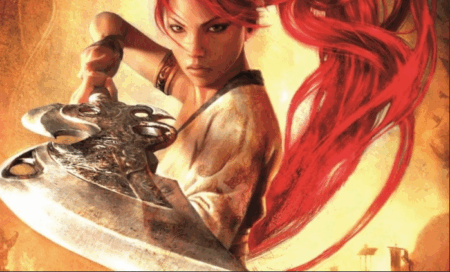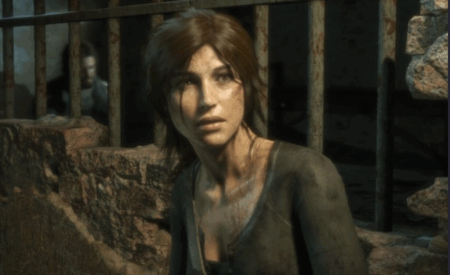Explore the hottest female game characters in the gaming industry, from iconic adventurers to intergalactic bounty hunters. Discover what makes these characters stand out and why they have become fan favorites.Since the advent of video games, female characters have evolved from supporting roles to central figures, sometimes even shaping the cultural landscape of the industry. Heroines like Resident Evil’s Jill Valentine or Heavenly Sword’s Nariko attract attention not only for their looks, but also for their ability to inspire players through complex stories. Let’s take a look at the very best.
Rayne from Bloodrayne

This bloody vampire should be remembered by everyone who lived through the gaming industry in the early 2000s. Raine is a dhampir, a half-breed born in 1915 from the union of the vampire Kagan and a human woman. Her mother was raped by Kagan, who then killed her entire family.
It is this background that shapes her thirst for revenge and determines her path as a vampire hunter. Bold, sarcastic, confident and independent. In her youth, she was cold and emotionally reserved, driven by anger and revenge.
The girl even appeared in the October 2004 issue of Playboy and was named one of the sexiest vampires and video game heroines. Some critics saw her image as too much of a fan service. However, the image became iconic in an era when heroines like Lara Croft also balanced strength and attractiveness.
While the BloodRayne series hasn’t achieved the popularity of franchises like Tomb Raider, Rayne remains a cult figure. Her appearances in films (albeit not entirely successful ones), comics, and even a cameo in Ready Player One (2018) have only cemented that status.
Nariko from Heavenly Sword

The red-haired warrior from Heavenly Sword stands out for her tragic story. She was born in a year when her clan was expecting a male savior, but instead received a girl, making her an outcast. Taking up the Heavenly Sword to save her father Shen and her clan from King Bohan, she accepts its curse, knowing it will consume her life force.
Her willingness to sacrifice herself for others allows her to be classified as a heroine archetype whose strength lies in self-sacrifice. With her fiery hair and warrior-like yet feminine appearance, Nariko has become a recognizable figure, as evidenced by numerous cosplays (such as those by Foxtale and Melissa Pearce ).
Nariko was even included in Complex’s list of “The 50 Greatest Video Game Heroines.” She has a pretty tragic fate (no spoilers), which makes it hard to put her in the category of just pretty female characters.
Miku Hinasaki from Fatal Frame

A 19-year-old girl who goes to the abandoned Himuro mansion in 1986 to find her missing brother Mafuyu. Miku uses a camera obscura, a mystical camera that belonged to her mother. The unusual gadget allows the girl to fight ghosts.
Miku’s motivations are driven by her love for her brother and a sense of duty. A fragile-looking girl with long dark hair, she wears simple clothes. Her simple appearance stands in stark contrast to the terrifying surroundings of Himuro’s mansion, as if to contrast her humanity and vulnerability with the paranormal forces she must face.
Mihu’s image has inspired many fan works, including art and mods. Although the Fatal Frame series also failed to turn into a major franchise, Mihu can be called an iconic character in the horror niche of games. First of all, due to her fragility, which contrasted well with the lore of the franchise.
Jill Valentine from Resident Evil 3: Remake

A member of the STARS squad, who has already survived the terrible events of the first Resident Evil. The girl tries to survive the zombie apocalypse and escape from the city, pursued by Nemesis – a biological weapon of Umbrella.
Jill’s main goal is to survive and expose Umbrella. The heroine prefers to act alone, which confirms her determination in the fight against the corporation. At the same time, she also suffers from post-traumatic stress disorder after the events of the first part and is under surveillance by Umbrella.
In the remake, Jill is made more expressive. She is sarcastic, emotional, and vulnerable at times. Her fight against Umbrella and Nemesis is accompanied by a personal motivation: revenge for betrayal. In the remake, her image became less sexualized, and the story turned out to be more personal. At the same time, the original Jill actually laid the foundation for strong female characters in games.
Lara Croft from Tomb Raider

The main character of the Tomb Raider game series, created by the British company Core Design and first appearing in 1996, Lara has become one of the most iconic figures in the gaming industry and a true pop culture icon.
An adventurer archaeologist who travels the world in search of ancient artifacts. In the 1990s, most protagonists were men, but Lara defied stereotypes. But it’s not just about the girl’s appearance.
Tomb Raider (1996) introduced the 3D platforming genre to the game, with puzzles, adventures, and shooting that were revolutionary at the time. Lara has since appeared in films (played by Angelina Jolie and Alicia Vikander), comics, books, and even commercials.
In remakes and reboots ( Tomb Raider 2013 , Rise of the Tomb Raider , Shadow of the Tomb Raider ), the developers gave Lara a deeper character development, making her more human and vulnerable, but maintaining her resilience. In her image, she showed that female characters can be no less cool and popular than male ones, and continues to inspire new generations of gamers.
Eva from Stellar Blade

Eva has become one of the most talked about figures in the gaming industry in 2024. Created under the direction of game director Kim Hyun-tae, she combines cyberpunk aesthetics with Korean cultural beauty standards. Inspired by real-life model Shin Jae-eun, her appearance has caused not only admiration but also controversy.
It was clear that Shift Up had spent a lot of resources on the girl’s appearance. For example, in Tachy Mode, Eva wears a black nanosuit with a metal wing, and in Fusion State, her white suit with a golden sword and angel wings gives her an almost divine appearance.
Her image has inspired female cosplayers such as Lee Da-hye and Larissa Rochefort , and has also led to the creation of figurines from Cerberus Project and JND Studios, which only prove her popularity among collectors.
Eva’s appearance has become part of a debate about the role of visual aesthetics in games. It has received mixed reactions due to its hypersexualized appearance. The revealing costumes and emphasis on her figure, particularly in trailers where the camera emphasizes her curves, have led to accusations of objectification and the male gaze. Gene Park of the Washington Post called her character “bland”, arguing that her design overshadows the depth of the story, while Ron Muyot of Push Square praised her as a “confident” heroine whose appearance enhances her role in the cyberpunk post-apocalyptic setting.
Senua from Hellblade: Senua’s Sacrifice

One of the most psychologically profound and emotionally charged characters in video games, the game, developed by Ninja Theory, and its heroine have been acclaimed for their bold depiction of mental illness within the context of a mythological narrative.
The premise is pretty good. According to the plot, a young warrior from the Pictish tribe (ancient inhabitants of Scotland) goes to Helheim to save the soul of her beloved Dillion from the goddess Hela. Senua suffers from psychosis, and her perception of reality is distorted by voices in her head.
To convey Senua’s disorder more realistically, Ninja Theory consulted with psychiatrists and people who had experienced psychosis. The girl’s journey to Helheim is a kind of allegory for the struggle with inner demons. On the one hand, Senua fights monsters, on the other, she overcomes fear, guilt and trauma (the death of a tyrant father, rejection by the tribe).
The girl’s face is modeled after actress Melina Jurgens, whose performance earned Hellblade: Senua’s Sacrifice a BAFTA for Best Performance. If you dig deeper, Senua is not a classic heroine. Her sacrifice is not in defeating evil, but in coming to terms with reality, which makes you think about the nature of consciousness.
Juliet Starling from Lollipop Chainsaw

The girl falls into the category of “notable” not only because of her eccentric appearance, but also because of the setting. The developers from Grasshopper Manufacture managed to create some crazy mix of zombie apocalypse, school romance and black humor, where Juliet combines the image of a glamorous cheerleader and a professional hunter of the undead.
Her main tool is a decorated chainsaw, which the girl uses to destroy zombies. Juliet’s image itself has become a parody of stereotypes about stupid blondes from American films. The heroine’s costume and behavior are deliberately exaggerated, although the girl is smarter and stronger than she seems.
The game itself is also filled with pop culture parodies, from Zombieland to references to the animated series Scooby-Doo. And the soundtrack includes pop-punk covers of classics and more. The composition You Spin Me Round, for example, was performed by Juliet herself.
Juliet is based on Jessica Nigri, a cosplay model and actress. Some reviewers accused the game of being overly sexualized, but the authors emphasized that it was a conscious parody of Hollywood cliches. At the same time, screenwriter James Gunn (the future director of Guardians of the Galaxy) placed his signature absurd humor into the dialogues.
Bayonetta from Bayonetta

An amnesiac witch from the Umbra clan who has been sleeping for 500 years, searching for answers about her past and confronting the angels of Paradiso, Bayonetta has also become a cultural phenomenon, inspiring female cosplayers, fan art creators, and collectible figures.
Her appearance in Super Smash Bros. (2015) for the Nintendo Wii U and Nintendo 3DS as a playable character only cemented her status, and cameos in other games such as The Wonderful 101 and the anime Bayonetta : Bloody Fate (2013) expanded her influence as a canon video game character.
Critics praised her as a heroine who upends stereotypes of sexualized characters, as Bayonetta uses her attractiveness as a tool of power, and her combat mechanics are based on changing clothes.
Unlike Stellar Blade ‘s Eve , whose fanservice controversies center on objectification, Bayonetta is perceived as a character who owns her sexuality, which sets the heroine apart from most others.
2B from NieR: Automata

A YoRHa android created to fight machines in a post-apocalyptic world, 2B initially appears cold and disciplined. Her eyepatch symbolizes her blindness to the corporation’s ideology, and her internal conflict between duty and emotion is particularly evident in one ending.
Unlike Fatal Frame’s Miku Hinasaki, whose story focuses on personal loss, 2B raises questions about the meaning of existence and free will. She stands out for her inclination to reflect and her ability to ask the right questions about the nature of humanity.
Her popularity is confirmed by her appearances in crossovers such as Soulcalibur VI, Final Fantasy XIV, and Gravity Rush 2. IGN and Eurogamer praised 2B for her versatility, noting that her character and story make her more than just a “sexualized android.”
Compared to Bayonetta’s more overt design, 2B’s fighting style seems more restrained, making her closer to Eva. Incidentally, in the Shifе Up project, she also appeared as a hero and even more – the Korean developers were largely inspired by the game NieR: Automata.
Sometimes, the influence of female characters in the gaming industry extends beyond the screen, manifesting itself in cosplay, fan art, and cultural discussions. Notable female protagonists aren’t always the result of hardcore fan service, but also a marker that helps introduce a new audience to a game or franchise. Some people don’t like it, but it works.